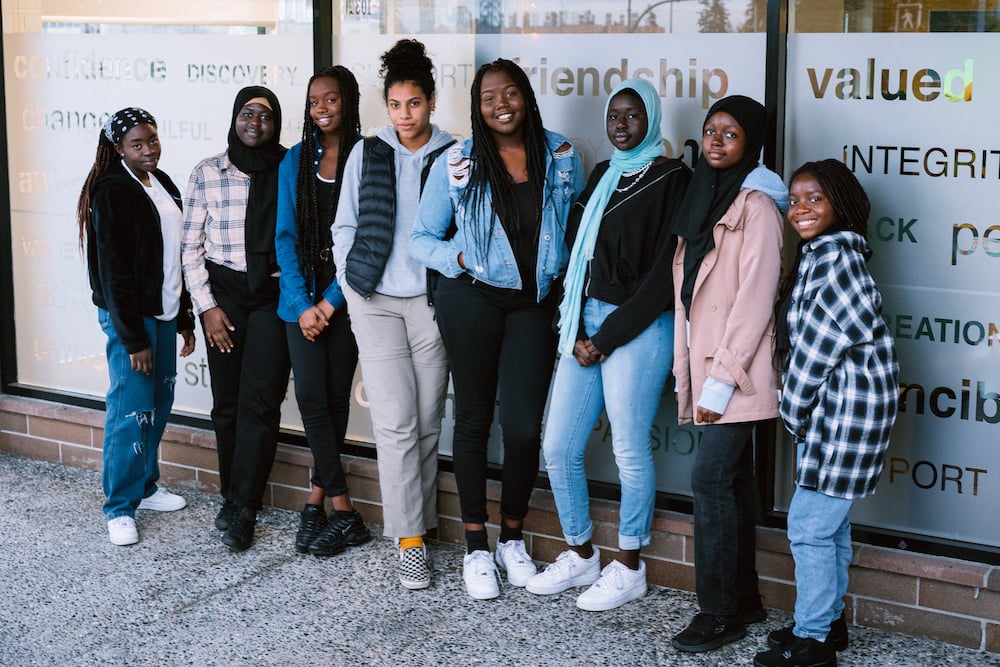Surrey schools reflect the city’s diverse population. But they’re not safe places for Black, Indigenous and people of colour who are subjected to bullying, says Annie Ohana, an Indigenous teacher advocate and social justice organizer.
“What I’m hearing from students directly is that they don’t feel safe in our buildings,” Ohana says. “When you talk about the mental health of our students, that’s what’s at stake here. If we don’t deal with the racism that is inherent in our structures, our curricula, and in the day-to-day, unfortunately you’re not going to have safe and secure schools.”
As an anti-oppression curriculum specialist and Indigenous department head at L.A. Matheson Secondary, Ohana said she often witnesses racism. And she doesn’t see teachers doing enough. When asked why, she says, teachers have told her they “aren’t ready” to teach the anti-racism programming she has suggested.
“They probably didn’t learn it in school, but to suggest that the health and well-being of our students comes second is problematic,” she says. “Colour matters, because we see white teachers predominately being the ones perpetrating this violence through misunderstanding and ongoing prejudice when they choose not to change.”
Fatuma Maki, a Grade 11 student in the district, sees the same racism at play in classrooms. As an example, she recalls how uncomfortable she felt when non-Black students and teachers repeatedly said the N-word while reading To Kill a Mockingbird.
“Just because it’s in a book, it’s fine? Then, once we say something, it seems like, ‘Oh, there’s the angry Black girl.’ We’re always going to look like the bad person in the situation,” she says.
The result is that students use the slur outside of class too, Maki says.
Exploring themes of race should certainly be part of the curriculum, she says, but educators need to be more considerate of how racism in the classroom impacts students of colour.
Maki, along with students Vanessa Wilson and Remas Elradi, runs the school group Daily Dose of Blackness. The trio says having more Black teachers on staff would help address the problem.
The three young women say they would have appreciated having a Black teacher to talk to during a racial conflict at their school last year, when a Black student was told he violated the dress code for wearing braids and a durag to school because they were “gang-affiliated.”
Teachers didn’t know what to do when Daily Dose of Blackness spoke out against the dress code, the teens say. Instead of working to implement a new code or offering an apology, the school did nothing. The student graduated and moved on, but the conflict remained unsolved.
“He kind of started this mini-revolution within the school, saying, ‘Justice for durags,’ and how this is part of our culture, you know? And teachers were like, ‘Now that student hates me.’ But it’s not about you,” says Elradi. “They just want you to be educated.”
On that front, Daily Dose of Blackness does its part, publishing articles that raise awareness of racism, such as the widely circulated “10 things Black students are sick of hearing.” Members are proud of the impact, saying it reflects what they go through.
Daavin Weston-Kilt, a senior student in the district, says racist jokes in the classroom are common at her school, too. As a white student, she has noticed that teachers get away with making inappropriate jokes and let racist comments by students slide in class.
She says her friends who are BIPOC don’t feel there are any options for them besides staying silent and waiting for the moment to pass, which creates a vicious cycle of repeated racism.
Weston-Kilt, who is currently taking her classes online, says it would be helpful to include the histories of people of colour in curricula across B.C.
“That missing piece is why students act out in this way,” she says. “Schools aren’t teaching about this history… but Canada is diverse. Surrey is diverse, and they aren’t including that diversity in curriculums.”
Surrey School District communication services manager Ritinder Matthew says she and her colleagues recognize that more must be done about racism.
“We need to do better in making students and staff feel safe to bring reports forward,” she says.
How many reports of racism there have been is unknown. While there is plenty of anecdotal evidence of racism in B.C. schools, incidents aren’t recorded, nor is racial data on students and teachers tracked in the province, making it hard to get a clear picture of the disparities that occur.
A petition launched last June by the Support Network for Indigenous Women and Women of Colour asked the provincial Education Ministry to track all reported incidents, as well as implement anti-racism policies, training and curriculum. So far, none of these actions have been taken.
All 60 school districts in the province have codes of conduct or policies that align with the BC Human Rights Code, but there is no specific anti-discrimination training provided to new hires in the K-12 system.
Matthew says the Surrey School District has started working with Racing to Equity, a U.S. consulting firm, to transform its racial equity goals into tangible action items and is planning to promote a series of public listening circles for staff, students and community members to share their voices.
And in April, Surrey will hold a four-week workshop series for teachers to “explore teacher beliefs and practices in relation to racial bias, review Canada’s Black history, and learn how to better support racialized and marginalized learners,” Matthew says.
Matthew says students and staff can report dangerous or illegal activity in their schools or community — including racism, discrimination and harassment — through the PSST website, a partnership between Surrey schools and the RCMP. Reports can be submitted anonymously for consideration by the school district, which “works with the individual or looks into the situation,” Matthews says.
As for hiring more teachers of colour, one Surrey teacher says it’s not just about increasing the number but providing opportunities for them to thrive and support students.
Michael Musherure, who teaches at Queen Elizabeth Continuing Education and Earl Marriott Secondary*, has been the only Black educator at the last three schools he’s taught at — not because people of colour don’t want to be teachers, he says, but because “the system is structured in such a way that it makes it difficult for [them] to get to the top.”
Two years ago, the B.C. government spent $3.1 million on teacher training programs to boost Indigenous teacher numbers and practices. Musherure says it’s time it widens that approach to invest in the futures of all people of colour.
Musherure has faced racism himself, but says being able to help youth desperate for guidance gives him hope.
“I’ve had the pleasure of teaching Black kids, and you should see their faces when they see a Black teacher. They just feel at home and you can see that,” he says. “The students who are white, they have people like them in the building, adults they can look up to as role models, but students of colour hardly see anyone who looks like them.”
While at Surrey’s Princess Margaret Secondary, Musherure fondly recalls Black students staying after class to tell him their stories, to confide in him and to chat about their days.
“When you know them more on that level, you can help guide them. You can’t guide them if you don’t know them,” he says. “For most students of colour, when they see a white figure of authority, their first thought is, ‘Watch your back.’ At least that’s what I felt. If they’re a good person, which many of them are, then it’s a slow process and you have to build that trust.”
All teachers should be receiving anti-racism training in their orientations, he says, especially in a district as diverse as Surrey’s.
“When we’re mandated to do this training, the idea of ‘I’m sorry, I didn’t know,’ is eliminated… it gives them a little bit of insight into how people of colour feel,” he says. “It eliminates excuses. It eliminates ignorance. It empowers so that when you speak, you know you’re speaking from an informed background.”
“When they get that insight, they can change their teaching methodologies, because if you don’t understand the effect of racism on racialized people, you will continue teaching a whitewashed curriculum.”
Ohana’s message to teachers is similar. Rather than being defensive, they should be open to learning and growing as part of their professional development and take advantage of the tools offered by the BC Teachers’ Federation or the Vancouver Elementary School Teachers’ Association.
The creation of anti-oppression or social justice committees in every school could create more safe spaces for open discussion as well, she says, noting that Daily Dose of Blackness has inspired lots of important conversations at her school.
“We need to hold teachers to account to be better at training themselves and finding the resources that are out there to promote the healthiest and safest environment for our kids, and that means stepping off this train of, ‘Settled colonial Canada can do no wrong,’” Ohana says.
“I encourage teachers to have these dialogues with fellow teachers. I encourage teachers to bring this up in their classrooms, and I encourage the district and the Ministry of Education to fund anti-oppression initiatives in a much stronger way.”
*Story updated on March 23 at 12:22 p.m. to correct the schools at which Michael Musherure teaches. ![]()
Read more: Rights + Justice, Education
















Tyee Commenting Guidelines
Comments that violate guidelines risk being deleted, and violations may result in a temporary or permanent user ban. Maintain the spirit of good conversation to stay in the discussion.
*Please note The Tyee is not a forum for spreading misinformation about COVID-19, denying its existence or minimizing its risk to public health.
Do:
Do not: